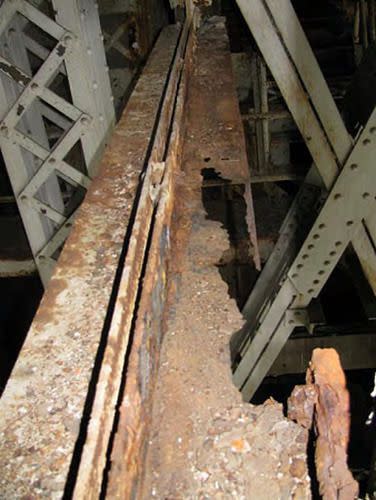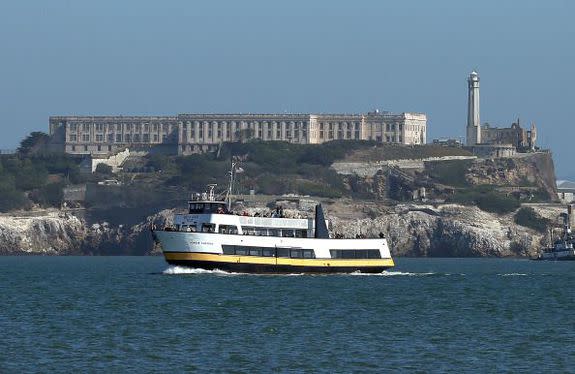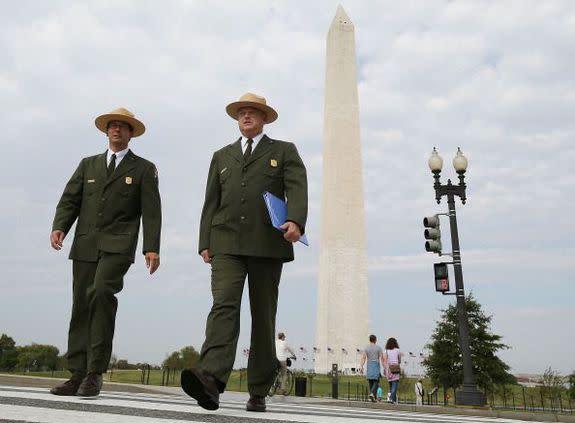Crumbling national parks mired in $11 billion backlog, but experts scoff at jacking up fees

Three years ago, the National Park Service banned trucks and buses heavier than 10 tons from crossing over the Arlington Memorial Bridge, a major transportation artery connecting Virginia to Washington D.C. And there's speculation that the U.S. Secret Service now refuses to cross the 82-year-old concrete span, though the agency would not confirm whether this was the case.
From afar, the bridge's neoclassical design — finished with sculptures of eagles and bas relief of bison — looks glorious. But inside, it's rotting.
"Most people would be horrified to look behind the curtains of parks," said Robert Manning, professor emeritus at the University of Vermont's Rubenstein School of Environment and Natural Resources.
SEE ALSO: The new Park Service head once allowed a billionaire to chop down 130 protected trees
The Park Service has quite a maintenance liability, accumulating an over $11 billion backlog in the upkeep of historic structures, trails, and roads that need to be repaired, and in some cases, held up. The agency is budgeted around $3 billion a year for the totality of its operations, which Manning notes, is less than one-tenth of one percent of the federal budget.
An influx of money is the obvious way to solve the parks' structural woes, but it's unlikely Congress will appropriate enough funding in the near term to shore up this failing infrastructure. For this reason, a group of around 150 sustainability experts, technologists, and business leaders are gathering in the Golden Gate National Recreation Area this weekend to conceive novel solutions to address the backlog.
The ideas produced during the "Parks and Tech Challenge" event, hosted by the Pew Charitable Trusts and the consulting company CivicMakers, will be vetted by a panel of park experts.
"This is not an attempt for technologists to solve problems for government or park staff," CivicMakers CEO Lawrence Grodeska told Mashable. "This is a collaboration."

Image: NPS/National Parks Conservation Association
The coming solutions — which could involve ideas such as making expensive and recurrent trail work cheaper — will certainly be welcomed by the Park Service if they're deemed useful. Few people, however, seem welcoming of the current administration's proposal to tackle the cash problem, which suggests raising entrance fees to $70 in 17 popular parks, including the Grand Canyon and Yellowstone. This will more than double the price of admission.
"I think it is incredibly stupid," said Jon Jarvis, who stepped down as director of the Park Service in January 2017, of the proposed fee increase.
While Jarvis is supportive of the park service fee program, as it brings in some $230 million annually, he's not in favor of imposing such a dramatic fee hike — as this would make some parks unaffordable or discouraging to some Americans.
"The national parks were established for the people — not some of the people or wealthy people. They have to be affordable to American people," said Jarvis.
"Raising prices to $70 is preposterous," agreed Manning. "It has no grounding in the reality of the issue."
The Interior Department estimates this fee increase, if it goes into effect this summer, will bring in another $70 million dollars. But this will likely have little impact on the greater budget problem.
"Let's say you get to $300 million," said Jarvis. "The backlog is $12 billion. You’re not going to make much of a dent."
Manning does concede that many Patagonia-clad park visitors are well-off, "can pay more, and they probably should" — but not if it means making admittance into parks inequitable.
"We need to lower barriers to get into the national parks, not raise them," said Manning.
A park service spokesman told Mashable that the agency is still reviewing comments about the proposed fee hike. The spokesperson said that a decision would be made "in consultation with the Department of Interior."

Image: Getty Images
Due to insufficient funds, the Park Service expected to completely close the decaying Arlington Memorial Bridge to vehicle traffic in 2021, rendering it an over-sized footpath. The bridge, however, was recently saved by political deal-making and a large dose of funding, to the tune of $227 million, with a sizable $90 million lump of support coming from the Department of Transportation. But the agency can't rely upon piecemeal funding efforts to fix a decades-long systemic problem.
"The Park Service is like managing small cities in which the population turns over every few days," said Jarvis. "There's incredible infrastructure associated with park systems," he said, noting that sewer systems, medical response, jails, roads, and communications systems all need to be maintained in often extreme, isolated environments.
Regardless of the novel solutions that may come out of the forthcoming Parks and Tech Challenge, the inescapable reality is that aging park infrastructure — some of which is centuries-old, is dependent upon significant increases in funding.
"We’re looking for some dedicated funding from Congress," said Emily Douce, director of budget and appropriations for the National Parks Conservation Association, in an interview.
"Congress talks a good talk about how much they love our national parks, but this is an issue they haven’t figured out how to address," she said.

Image: Getty Images
A bill, however, has been introduced in both houses of Congress to address the park system's infrastructure woes — but its source of funding might seem incongruous with the Park Service's conservation goals. Called the National Park Service Legacy Act, Douce says the bill has the support of 12 senators and 56 representatives — still a far cry from becoming law.
As currently written, the law would draw from taxes collected from the extraction fossil fuels — such as coal, oil, and natural gas — from both on-shore and off-shore locations, including public lands managed by the Interior Department.
In 2017, the federal government received $4.5 billion in taxes from off-shore drilling activities. Much of this, $3.5 billion, is set aside as unassigned spending — and the bill hopes to draw from these funds.
Since the Trump Administration took office, the Department of the Interior — whose agencies grant permits for fossil fuel extraction — has already successfully opened up previously-protected land for commercial use, which could mean drilling and mining. This was most apparent when President Trump, under the recommendation of Interior Secretary Ryan Zinke, decided to dramatically slash the size of two national monuments in December 2017. Bears Ears National monument was reduced by a staggering 80 percent, losing over a million acres.
Former park director Jarvis suggested a more conventional source of park funding — though likely far less substantial — which is increased philanthropy. For instance, billionaire businessman David Rubenstein donated $18.5 million in 2015 to restore the Lincoln Memorial.
But philanthropy will have its limits, not least because many critical park infrastructure needs aren't as attractive as a sponsorship that involves sprucing up President Lincoln's heavily-visited memorial.
"It’s not a glamorous thing for companies to invest in new toilets or water systems," noted Manning.
Some thirty years ago, Manning visited the north rim of the Grand Canyon, which gets water by piping it up from a spring. Decades ago, the pipes were broken. Manning visited again last year, and again, the pipes were broken.
"I’m sure every year the park asks for more money and it’s still going on," said Manning.
"That’s an example of a crown jewel park that can’t even fix its water system."
WATCH: Monkeys are being cloned inside a Chinese lab. This is what they look like.


